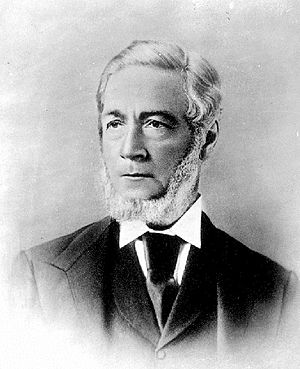Alexander Caulfield Anderson facts for kids
Quick facts for kids
Alexander Caulfield Anderson
|
|
|---|---|

Anderson c. 1880
|
|
| Born | 10 March 1814 Calcutta, British India
|
| Died | 8 May 1884 (aged 70) |
| Occupation |
|
| Spouse(s) |
Eliza Birnie
(m. 1837) |
| Children | 13 |
Alexander Caulfield Anderson (born March 10, 1814 – died May 8, 1884) was an important figure in Canadian history. He was a British fur-trader, explorer, and government worker. He worked for the Hudson's Bay Company (HBC), a famous fur trading company.
Anderson came to Canada from Europe in 1831. He became a leader at many forts in British Columbia. He even helped start new outposts. In the late 1840s, he explored new ways for the HBC to connect its forts in the middle of the country to the Pacific Ocean.
He retired from the HBC in 1854. But he soon moved to Victoria, British Columbia, to work for the government. In 1876, he became the first inspector of fisheries for British Columbia. He even suggested building the province's first fish hatchery.
In 1882, he got stuck on a sand bank overnight. This made his health much worse. He passed away two years later. Many places in British Columbia and Washington state are named after him today.
Contents
Early Life and First Steps
Anderson was born near Calcutta, India. His father was Robert Anderson and his mother was Eliza Charlotte Simpson. His family moved to Essex, England, in 1817.
In March 1831, Alexander and his brother joined the Hudson's Bay Company. They moved to Canada to work. He spent a year in Lachine, Lower Canada. Then he moved to Fort Vancouver, near the Columbia River.
In 1833, he helped build Fort McLoughlin. He was the second-in-command of the group. Later, he was part of a team trying to build a new trading post. This was along the Stikine River, but the Russians stopped them.
Leading the Hudson's Bay Company
Anderson was moved to the New Caledonia area of the HBC. This area covered the north-central part of British Columbia. He stayed there for five years. On one trip, winter came early. He and his group had to go back to Jasper. Then they had to go to Edmonton because they ran out of supplies. An investigation found that he had managed the situation well.
In 1836, he took charge of a post along the Fraser River. He stayed there for three years. After that, he moved to Fort George for a year. Then he was temporarily in charge of Fort Nisqually. In 1841, he was the first European to make the Naches Pass wider and use it.
In 1842, he was put in charge of the yearly trip to York Factory. This trip was called the annual brigade. He then became the leader at Fort Alexandria. He stayed there until 1848.
Exploring New Routes
After the Oregon Treaty, the border between the United States and British North America changed. It was set along the 49th parallel. The HBC used to travel along the Columbia River to get to Fort Vancouver. But now, part of this route was in the United States.
The HBC asked Anderson to find a new route. This new route needed to connect the forts in the interior to the Pacific Ocean. They chose Fort Langley as the ocean connection. The Fraser River was chosen as the main path.
Peter Skene Ogden, who was in charge of New Caledonia, suggested a route. It went south of the Fraser River's canyons. Anderson tried this route, but it took nine days and was too hard. He then tried a route through the Cascade Mountains. He found this route more practical. However, heavy snow could close it for several months each year.
The HBC leaders asked Anderson to find an even better route. In 1847, Anderson mapped a route along the Coldwater River and Uztlius Creek. This trail was also too difficult. So, Anderson's route through the Cascade Mountains, with small changes, was used from 1848 to 1860.
Life After Fur Trading
Anderson took command of Fort Colvile in 1848. He stayed there until 1851. Then he became second-in-command at Fort Vancouver. He retired in 1854 and settled in Cathlamet.
In 1858, he traveled north to check on a gold rush. James Douglas, a key figure in Victoria, met Anderson. He convinced Anderson to take a job with the government in Victoria. Anderson became the city's postmaster. He also collected customs fees for British Columbia.
Anderson started writing about fish species in British Columbia in 1860. He also wrote about how local Indigenous people caught fish. In 1867, he suggested bringing salmon eggs to rivers like the Mackenzie River and Saskatchewan River. This would provide food for future settlers. In 1871, he wrote an essay called The dominion at the west; a brief description of the province of British Columbia. It won a provincial prize.
In 1876, he became British Columbia's first inspector of fisheries. He was in charge of all coastal and inland waters. He held this job until he died. He also worked on a group dealing with Indigenous land in British Columbia. He wrote a book about his life called “History of the northwest coast.” In 1877, he suggested building British Columbia's first salmon hatchery. Construction on this hatchery began in 1884.
Family, Passing, and Lasting Mark
Anderson married Eliza Birnie in August 1837. They had 13 children together.
In 1882, he had to spend a night on a sand bar while traveling. This event caused his health to get worse. He passed away on May 8, 1884, when he was 70 years old.
Many places are named after Alexander Caulfield Anderson. These include Anderson Lake, Anderson River, and Anderson Island.

